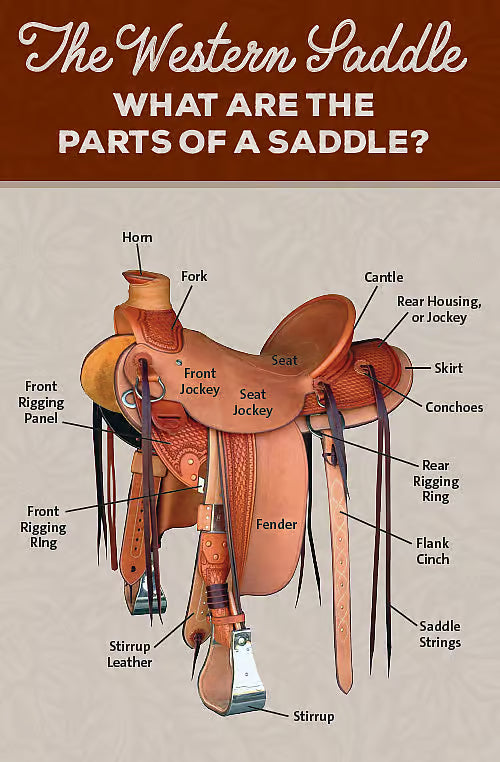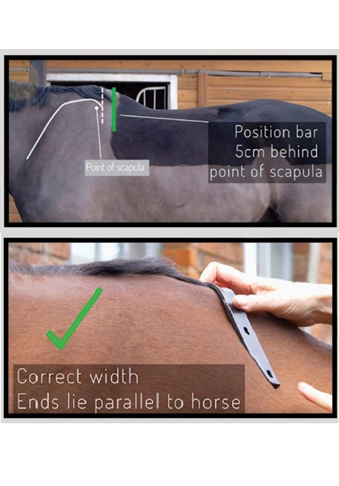How to Measure: Western Saddles
A great idea! A well-fitting Western saddle is just as crucial as a well-fitting English saddle for both horse and rider. Unlike English saddles, Western saddles have different terminology and key measurements that are vital to know when ordering, especially without a professional fitter present.
Ordering a Western saddle requires careful attention to three key areas: the rider's seat size, the saddle's tree and gullet for the horse, and the skirt length. Getting these right will ensure comfort and proper weight distribution.
Here is a guide on how to measure a Western saddle for ordering!

Step 1: Measuring for the Rider: Seat Size
The seat size is the most important measurement for the rider's comfort and balance. It is measured from the base of the horn to the top of the cantle in a straight line.
- How to measure: A rough estimate for your Western seat size is to consider your pant size. A general rule of thumb is to add four inches to your pant size to find your seat size. For example, a person who wears a size 28 pant might start with a 12-inch seat.
- Common Sizes: Adult Western saddles typically range from 12 inches to 17 inches. A smaller adult might fit a 14-inch seat, while a larger adult might need a 16-inch or 17-inch seat.

Step 2: Measuring for the Horse: Tree Size & Gullet Width
The tree is the foundation of the saddle, and its size dictates how the saddle fits your horse's back. A proper fit prevents pressure points and ensures your horse is comfortable.
- How to measure: The best way to measure is to use a specific gullet measuring tool or a flexible wire. Place the tool or wire over the horse's withers, two to three inches behind the shoulder blade, and trace the shape.
- Common Tree Sizes: Western saddle trees are typically categorized as: Semi-Quarter Horse Bars (SQHB): This is the most common fit, designed for horses with narrower, more "A-frame" backs. The gullet is usually about 6 inches wide. Full Quarter Horse Bars (FQHB): These are designed for wider, more muscular horses with flatter backs. The gullet is wider, often around 6.5 to 7 inches. Arabian, Haflinger, or Draft: These are for specific breeds with very wide, flat backs and no pronounced withers. The gullet can be 7 inches or wider.

Step 3: Saddle Skirt Length
The skirt is the part of the saddle that extends over the horse's back. An overly long skirt can cause discomfort by putting pressure on the horse's loins.
- How to measure: You should measure your horse's back from the back of the shoulder blade to the last rib. The saddle's skirt should not extend past this point.
- Common Lengths: Western saddle skirts can range from as short as 24 inches for a youth saddle to over 28 inches for an adult show saddle.
Important Tips for Sizing
A well-fitting Western saddle is the key to comfort and performance for both you and your horse. By taking the time to measure accurately and understanding the differences in seat size, tree width, and skirt length, you can make a more informed decision when ordering. A proper fit ensures that the saddle distributes your weight evenly, prevents pressure points on your horse's back, and allows you both to perform your best in the arena or on the trail.
Shop Western Saddles
-
Tough1 Medina Roughout Barrel Saddle
Regular price Starting at: $269.00Sale price Starting at: $269.00 Regular priceWas: $393.80Save: 32% off -
Eclipse By Tough1 Round Skirt Competition Saddle
5.0 / 5.0
(3) 3 total reviews
Regular price Starting at: $135.00Sale price Starting at: $135.00 Regular priceWas: $281.60Save: 52% off -
King Series Braden with Silver Trail Sdl
3.5 / 5.0
(2) 2 total reviews
Regular price Starting at: $187.00Sale price Starting at: $187.00 Regular priceWas: $371.80Save: 50% off -
Eclipse by Tough1 Synthetic Barrel Saddle
5.0 / 5.0
(1) 1 total reviews
Regular price Starting at: $138.00Sale price Starting at: $138.00 Regular priceWas: $259.60Save: 47% off -
Eclipse Tough1 Synthetic Rnd Skirt Trail Saddle
Regular price Starting at: $201.00Sale price Starting at: $201.00 Regular priceWas: $349.80Save: 43% off -
King Series McCoy with Silver Trail Saddle
5.0 / 5.0
(2) 2 total reviews
Regular price Starting at: $209.09Sale price Starting at: $209.09 Regular priceWas: $393.80Save: 47% off -
King Series Junior Premier All Around Saddle
Regular price Starting at: $145.00Sale price Starting at: $145.00 Regular priceWas: $281.60Save: 49% off -
Tough1 Treeless Endurance Saddle
5.0 / 5.0
(1) 1 total reviews
Regular price Starting at: $169.00Sale price Starting at: $169.00 Regular priceWas: $303.60Save: 44% off -
Royal King Youth Hawley Barrel Saddle
Regular price Starting at: $324.00Sale price Starting at: $324.00 Regular priceWas: $523.60Save: 38% off -
Western Fleece Seat Cushion
4.5 / 5.0
(35) 35 total reviews
Regular price Starting at: $26.99



















